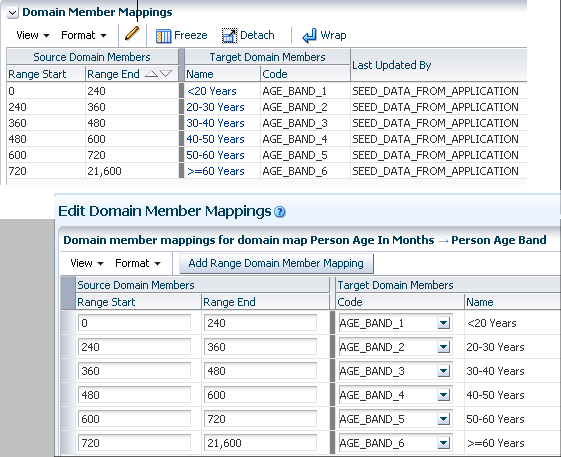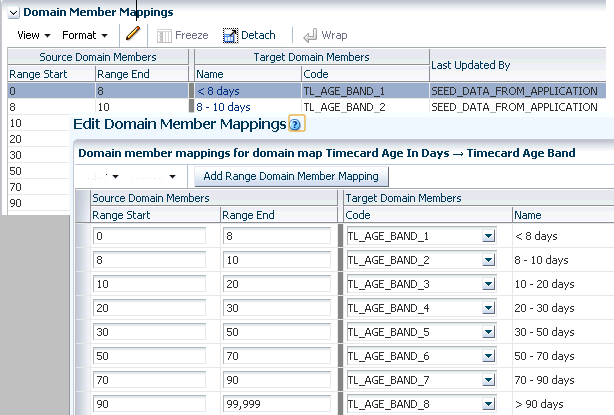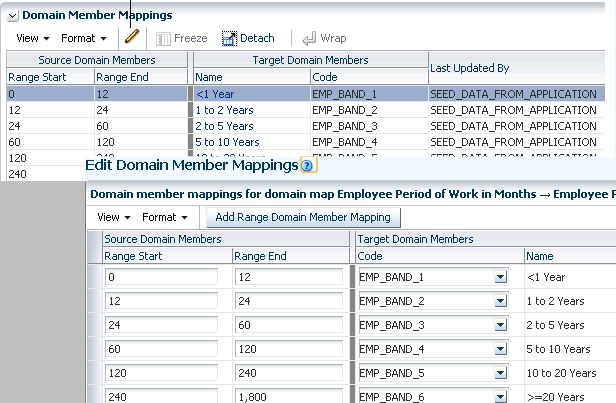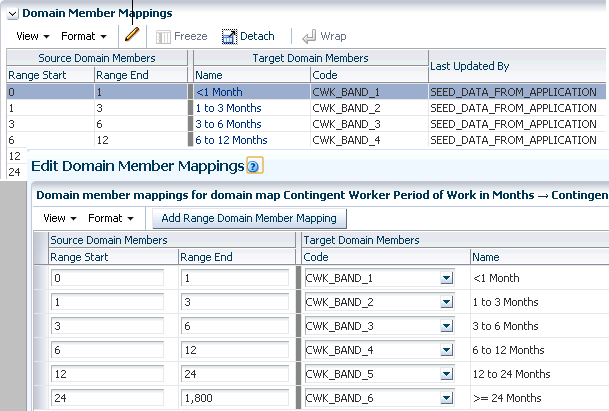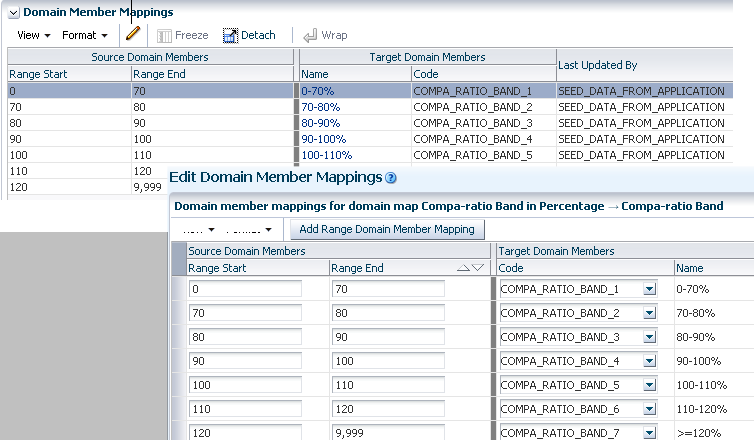About Configuring Band Dimensions
There are seven Band Dimensions that HR Analytics make use of. The purpose of this task is to provide information about the band dimensions, and all that is needed to configure the bands in these tables.
Optional or Mandatory
The default solution has bands configured based upon industry best practices. If the default bands meet your business needs, then no further configuration is required. Otherwise, this task is mandatory.
Overview of Band Dimensions
To enable data analysis based on various groups of a given attribute, Oracle BI Applications provides an option to configure your choice of groups, or bands, for these seven attribute families:
-
Person Age
-
Job Requisition Age
-
Time Card Age
-
Performance Ratings
-
Period of Service
-
Compa Ratio
-
Learning Grade
The band data that you configure is stored in seven corresponding dimension tables.
| Dimension Table | Description |
|---|---|
|
W_AGE_BAND_D |
Age Band table. This table breaks down the ages of people into different bands to help determine the age ranges the people fall into. The table has two levels: LEVEL_ID = AGE_BAND. This level defines the age bands. LEVEL_ID = AGE. This level defines the age (in months) for a person. |
|
W_JOB_RQSTN_AGE_BAND_D |
Job Requisition Age Band table. This table breaks down the age of the job requisition into different bands to help determine the age range the job requisition falls into. The table has two levels: LEVEL_ID = RQSTN_AGE_BAND. This level defines the job requisition age bands. LEVEL_ID = RQSTN_AGE. This level defines the job requisition age (in months). |
|
W_TLB_AGE_BAND_D |
Timecard Age Band table. This table breaks down the age of the time card into different bands to help determine the age range the time card falls into. The table has two levels: LEVEL_ID = TIMECARD_AGE_BAND. This level defines the time card age bands. LEVEL_ID = TIMECARD_AGE. This level defines the age (in days) for a time card. |
|
W_PERFORMANCE_BAND_D |
Performance Band table. This table breaks down the performance ratings into different bands to help determine the level of quality of a candidate. The table has two levels: LEVEL_ID = PERF_BAND. This level defines the performance rating bands. LEVEL_ID = PERF_RTNG. This level defines each normalized performance ratings (in integers up to 100) for a person. |
|
W_PRD_OF_WRK_BAND_D |
Period of Work Band table. This table breaks down employees and contingent workers into different bands to help determine the time that the employees or the contingent workers have been employed. The table has three levels: Two levels define the bands: LEVEL_ID = POW_BAND_EMP defines the employees' period of work band; LEVEL_ID = POW_BAND_CWK defines the contingent workers' period of work band. LEVEL_ID = POW. This level defines the period of work (in months) for a person. |
|
W_COMPA_RATIO_BAND_D |
Compa Ratio Band table. This table breaks down employee's Compa Ratio (percentage) values into different bands to help determine the distribution of Compa Ratio within the organization. LEVEL_ID = COMPA_RATIO_BAND. This level defines the Compa Ratio bands. LEVEL_ID = COMP. This level defines the Compa Ratio for a person. |
|
W_LM_GRADE_BAND_D |
Learning Grade Band table. This table breaks down the Learning scores into different grade bands to help determine the quality of a learner with respect to the course opted for. The table has two levels: LEVEL_CODE = LM_GRADE_BAND. This level defines the learning grade bands. LEVEL_CODE = GRADE. This level defines the learning score for a learner corresponding to a give course opted for. |
The Bands against the supported attributes (all seven) are pre-seeded within Configuration Manager. However, if you want to change the default bands set up for different base values, you edit the pre-seeded configurations using the 'Manage Domain Mappings and Hierarchies' option in the task pane of Configuration Manager. The lower half of the resulting screen displays the Domain Member Mapping section. Screenshots of the pre-seeded mapping for each supported attribute are shown below.
Job Requisition Age Bands
Timecard Age Bands
Performance Bands
Period Of Work Ratio Bands - Employee
Period Of Work Ratio Bands – Contingent Workers
Compa Ratio Bands
